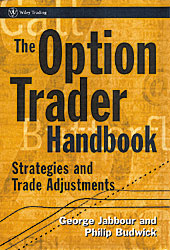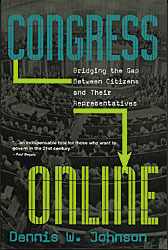|

Option Trading
 As director of GW’s Master of Science in Finance program, a frequent speaker on option trading and valuation, and an active equity and derivative trader, business professor George Jabbour put years of experience into The Option Trader Handbook: Strategies and Trade Adjustments (John Wiley & Sons, 2004). As director of GW’s Master of Science in Finance program, a frequent speaker on option trading and valuation, and an active equity and derivative trader, business professor George Jabbour put years of experience into The Option Trader Handbook: Strategies and Trade Adjustments (John Wiley & Sons, 2004).
For many traders, navigating the increasingly volatile markets during the past few years has proven no easy task. Jabbour and co-author Philip Budwick, a managing director of both Global Asset Investments and Budwick Investment Group, designed the book for intermediate to advanced traders to meet the growing need for them to learn how options can be used for better risk management.
A craft that requires instinct and creativity, making adjustments to stock or options positions “is one of the most overlooked and underutilized skills in trading,” the authors say. By utilizing the correct strategies and trade adjustments, it is possible for investors to protect and boost profits, minimize losses, and trade with less risk. While the authors say that many investors know how to trade stocks and/or options, not many know how to use options as a means to reduce risk and enhance one’s profile.
Step by step, using charts and spreads, Jabbour and Budwick advise readers on making trade adjustments by discussing the basics of risk and trade management theory and outlining tools such as time value premium, option pricing, and synthetic positions. The authors outline the different types of trade adjustments that can be made, what situations are appropriate for each adjustments, and the right time frame in which to make adjustments.
“Jabbour and Budwick’s unique approach to strategies and trading moves options analysis out of the laboratory and onto the painter’s canvas,” says William E. Seale, principal and chief investment officer for ProFund Advisors. “Understanding this refreshingly new viewpoint is essential for any options trader looking to expand both his horizons and his wallet.”
House of Dreams
 A world-renowned example of avant-garde architecture, the Charnley House in Chicago is the headquarters of the Society of Architectural Historians and a National Historic Landmark. The Charnley House: Louis Sullivan, Frank Lloyd Wrights, and the Making of Chicago’s Gold Coast (University of Chicago Press, 2004) by American studies professor Richard Longstreth explores internal and external aspects of the house and explains the house’s place in the context of American domestic architecture. A world-renowned example of avant-garde architecture, the Charnley House in Chicago is the headquarters of the Society of Architectural Historians and a National Historic Landmark. The Charnley House: Louis Sullivan, Frank Lloyd Wrights, and the Making of Chicago’s Gold Coast (University of Chicago Press, 2004) by American studies professor Richard Longstreth explores internal and external aspects of the house and explains the house’s place in the context of American domestic architecture.
A collection of essays by Longstreth and renowned architectural historians, the book places special emphasis on tackling the issue of the building’s design team. While many credit Frank Lloyd Wright, Louis Sullivan’s chief assistant at the time, with the house’s scheme, the work sheds new light on how the house displays the fingerprints of both artists. The continuing debate about the house’s authorship cements the Charnley House’s importance in the history of modern American architecture.
“The essays are written from a rich variety of viewpoints and explore many previously unasked questions. Thus the book serves not only as an engaging portrait of the house itself, but also as a testimony to the current vitality of the discipline of architectural history in the United States,” says Joseph Sirey, author of The Chicago Auditorium Building: Adler and Sullivan’s Architecture and the City.
Charnley House is beautifully illustrated with images and drawings that have never before been published, helping the reader more fully experience the detail and distinction of the house and the intricate work of its architects. Together, the essays and illustrations illuminate the intricate internal and external elements of the house, as well as its historical significance in the field of architecture and the city of Chicago.
Digital Democracy
 The result of a research project by GW and the Congressional Management Foundation, Congress Online: Bridging the Gap Between Citizens and Their Representatives (Routledge, 2004) by Associate Dean of the Graduate School of Political Management Dennis W. Johnson delineates the possibilities and challenges of Congress’ use of technologies and new media, particularly the Internet. The result of a research project by GW and the Congressional Management Foundation, Congress Online: Bridging the Gap Between Citizens and Their Representatives (Routledge, 2004) by Associate Dean of the Graduate School of Political Management Dennis W. Johnson delineates the possibilities and challenges of Congress’ use of technologies and new media, particularly the Internet.
“Some on the Hill consider e-mail to be a bane, but we should consider it a boon. It’s a powerful new link between the public and their representatives. There are ways to do it right and ways to do it wrong, and Congress Online shows the difference,” says Sen. Patrick Leahy (D.-Vt.), co-founder and co-chair of the Congressional Internet Caucus.
As online strategist and publisher of Democracies Online Steven L. Clift puts it, “An information-age revolution in citizen expectations is running smack dab into the slow evolution of Congressional practices online. The future of democracy is in the balance.”
While more and more Americans turn to the Internet as a means of gathering information and voicing concerns, Congress Online helps citizens and politicians navigate new media.
Though many constituents use e-mail and advanced technology to voice concerns to their representatives, Johnson points out that laptops aren’t even allowed on the floor of the House or Senate. But the demands of a technologically driven world are being felt by legislators, and Johnson offers communications strategies that are relevant not only to decision-makers, but also to citizens who want to be well informed about politics. As the Information Age gains momentum, Congress Online offers the reader methods of forging a new and more efficient connection between political leaders and the American people.
—Laura Ewald
Back to top | Fall 2004 Table of Contents
|